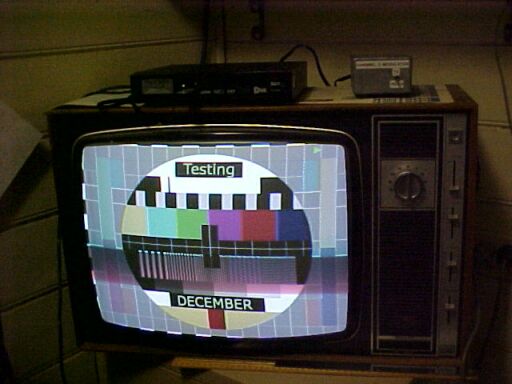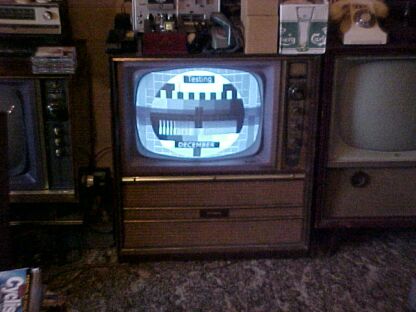Philips PM5544 Test Pattern in your own workshop for
$69.
Once upon a time, the PM5544 test pattern was transmitted most of the
day on SBS Channel 0 and 28. It was of considerable use to anyone working
with television and video equipment. However, about ten years ago after
all the other channels had gone 24hr, SBS followed and thus no more test
pattern. For the intervening years I have had been using a VHS recording
I did of the pattern while it was still being broadcast. This tape is certainly
showing its age, being recorded in 1994.
The Philips pattern generator that produces this pattern was a piece
of expensive equipment only a TV station can afford. But now there's a
much cheaper method.
I acquired a couple of DVX555 digital boxes from Strathfield Car Radio
which I talk about elsewhere. Basically they are a standard definition
digital box with the added feature of an optional hard disc to record your
programs on. At the time of purchase in 2008, these boxes were only $69
which was incredibly good value. However, be prepared to replace the electrolytic
capacitors in the power supply and video sections if you have one of these
boxes. They fail after a few years of continuous use.
The feature I'm mentioning here is they also have a USB socket to take
a standard memory stick. The box will display .jpg files on such a stick.
Well, it just so happens I had a .jpg of the Philips test pattern. I couldn't
believe the quality. I know .jpg is compressed but the resulting image
is as good as the off air pattern. Even the frequency resolution bars produce
the moiré pattern with the 4.43MHz chroma subcarrier!
NTSC output as well as PAL.
This box has another useful hidden feature. It can output in NTSC.
This proved invaluable when restoring my Sentinel 400TV ( U.S made TV set)
as there was what appeared to be a fault in the vertical oscillator, or
output, in that good linearity could not be obtained with the set fed with
the local 625 line 50 field signal. When I fed this set from the DVX555
set to produce NTSC output, and thus 60 fields, the linearity was much
better. This confirmed that I hadn't made a mistake during component replacement
or the circuit was incorrect. Instead, it showed the vertical section requires
some modification (among the other usual sound IF and tuner adjustments)
to work on the Australian off air signals. Incidentally, even with a 7"
picture tube, the line structure of the 525 line picture was more noticeable
than the local 625 line standard.
So, if you're into collecting NTSC equipment this box will be very
useful as you can confirm correct operation prior to modifying for local
operation. Why the option of NTSC output has been provided I don't know
as it is not the broadcast standard in Australia. Even though a lot of
modern TV sets sold in Australia are multistandard and can thus play NTSC
in colour, you wouldn't want to use the box this way normally, due to the
lower resolution and poor colour reproduction inherent with the NTSC system.
It could simply be that the the digital to analog converter IC's in this
box are also used in boxes sold in NTSC countries.

The DVX555 feeds into a homemade channel 0 modulator, as like most
Australian sets of this age there is no UHF or AV inputs. The set is one
of my Decca 33's.
This is a hybrid set with valves in the deflection and audio stages.
It's based on the British Decca 30 Bradford chassis. The Aussie version
differs in that it uses a proper transformer isolated power supply and
has a 13 channel VHF turret tuner with appropriate vision and sound IF.

Test pattern as displayed on my 1957 Kriesler 79-1. The DVX555 was
fed into a Rank Arena RV340 (JVC HR7200)video recorder to provide the channel
3 VHF signal. This is the set described here using my vertical blocking
oscillator transformer substitute: https://www.cool386.com/vertical/vertical.htm
Home



